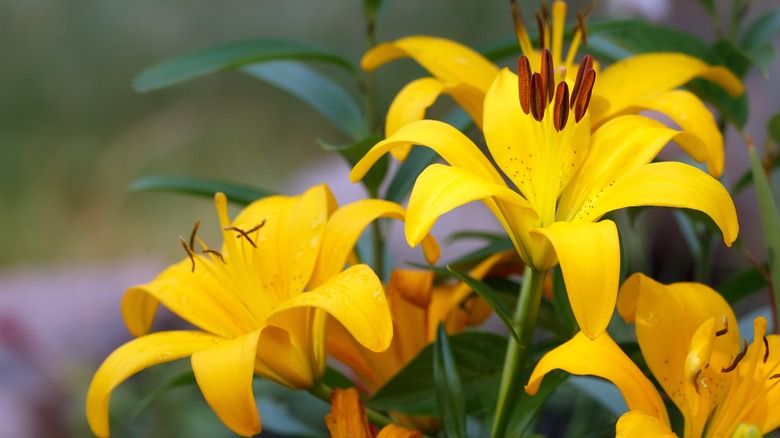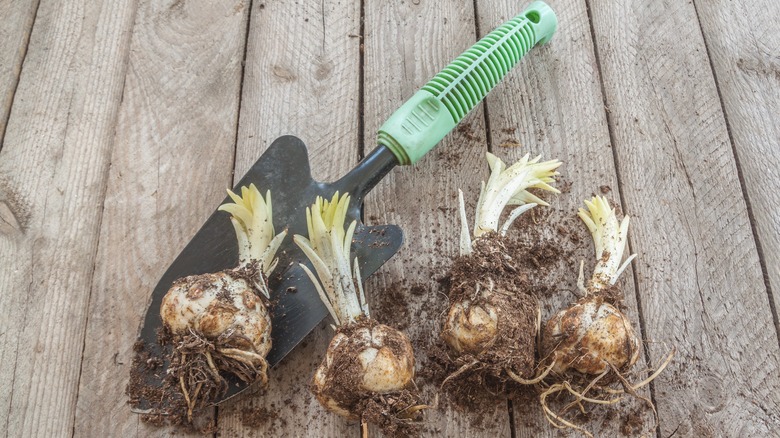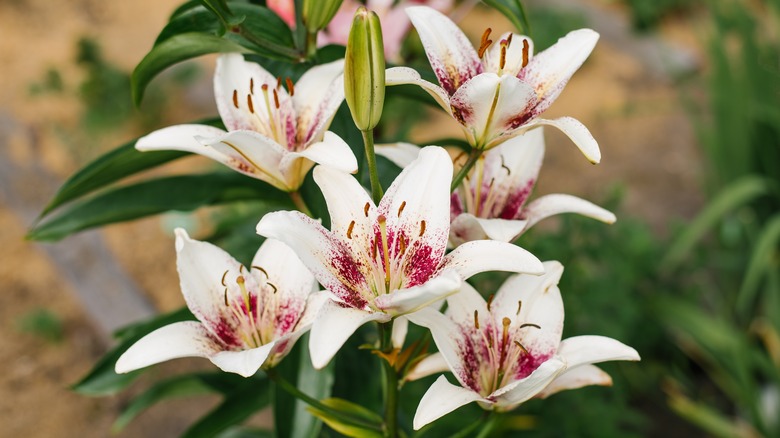How And Where To Plant Asiatic Lilies For Gorgeous Blooms Every Summer
Adorned by many for their bright colors and long blooming season, Asiatic lilies (Lilium-Asiatic hybrids, formerly Lilium asiatica) release their star-like blossoms early in the season. Unlike other members of the Liliacea family, these lilies are hybrids that aren't fragrant but come in a wide array of colors like pink, yellow, orange, red, white, purple, and even variegated. Despite their exotic appearance, they tend to be low-maintenance and can thrive in most conditions. Hardy in zones 4 through 8, they can grace gardens with their beauty in several states, opening their blooms in spring to summer.
With multiple cultivars to choose from, planting Asiatic lilies is the perfect way to add splashes of color to your garden. You can choose a favorite variety or two or purchase a bundle that includes a few different shades. Extremely versatile, Asiatic lilies make the perfect additions to several garden styles, including cottage and traditional gardens. They're also popular in bouquets, so plant them beside suitable companions, like cornflower (Centaurea cyanus), to start a cutting garden and create your own charming floral arrangements. Left outdoors, the flowers will bring more pollinators to your garden, helping to promote a diverse ecosystem in your yard. Adding Asiatic lilies to your landscape may look a little different than planting other species in the family, though the process is relatively simple. Let's get into how and where to plant these flowers so you can enjoy their summer blooms each year.
How and where to plant Asiatic lily bulbs
These dazzling lilies will bring color to your garden when given the proper growing conditions. Well-drained soil is a key ingredient for planting Asiatic lilies. Compact soils, like clay, hinder drainage and airflow, which can lead to bulb rot. Loamy or sandy soil works best, and they can handle most kinds of soil pH types. Another factor in determining the best spot in your garden to plant lilies is how much sun they'll receive. These flowers like full sun to partial shade, so choose an area that receives at least six hours of sunlight to get the most prolific blooms. If you're planting taller varieties, a spot near a fence, shrub, or other windbreakers will help protect them from damage.
Like many flowering bulbs, the best time to plant them is in early autumn. This allows the small plants to develop a strong root system before going dormant over winter. For each bulb, dig a small hole that is three times the bulb's height deep and place it into the soil with the pointed side facing up. Asiatic lilies need some space, so make sure you plant them at least 8 inches apart. Top with soil and give the site a good watering. Continue watering the bulbs weekly for about a month to help them kick-start building their roots, then hold back on watering over winter. Add a layer of mulch over each spot to keep your lilies insulated and retaining moisture.
Ongoing care and maintenance for Asiatic lilies
Once established, Asiatic lilies are relatively low-maintenance and easy to care for. One thing these hardy flowers cannot tolerate, however, is dry soil. Make sure they get an inch or two of water each week during the growing season. You may need to water more frequently during dry, hot periods, so it's best to frequently check the soil's moisture rather than going off of a schedule. Once buds appear, feed your lilies with a natural fertilizer, like fish emulsion, or a balanced synthetic fertilizer, like 5-10-5 or 10-10-10, for vibrant blooms. As perennials, these flowers will return each year, often with more bulbs hiding beneath the dirt. Divide them in early fall by carefully digging them out and gently separating them.
Asiatic lilies bloom once each season, typically in early-to-mid summer, and have a long blooming season lasting up to a month. As the flowers die off, you can deadhead spent blooms to allow the plant to focus energy on root and foliage growth rather than producing seeds. However, you don't want to prune the healthy green leaves and stems, as they'll continue photosynthesizing. As the weather cools down, you can cut the foliage back and layer them with mulch. Lilies in containers are more vulnerable to frost, so you'll want to keep them in a protected area, such as the basement, garage, or shed. These plants need to have a dormancy period, so avoid growing them indoors during this time.


